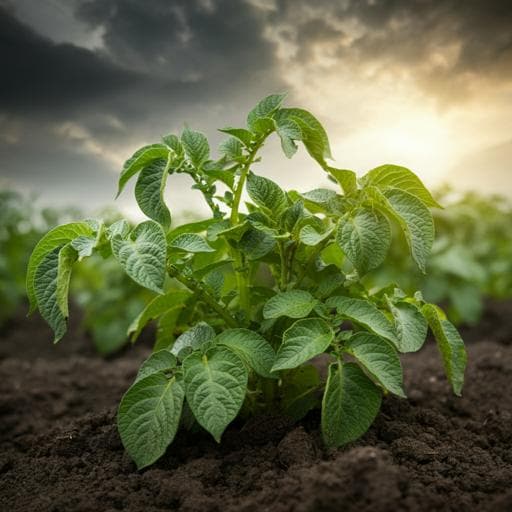
Agriculture
Extreme drought and rainfall had a large impact on potato production in the Netherlands between 2015 and 2020
P. J. A. M. Mulders, E. R. V. D. Heuvel, et al.
This study conducted by Puck J. A. M. Mulders, Edwin R. van den Heuvel, M. J. G. (René) van de Molengraft, W. P. M. H. (Maurice) Heemels, and Pytrik Reidsma reveals that extreme weather events, such as drought and heavy rainfall, account for a staggering 98% of year-to-year potato yield fluctuations in the Netherlands. High-intensity rainfall was found to reduce yields by 36%, while drought caused a 13% reduction, emphasizing the urgent need for adaptive strategies.
~3 min • Beginner • English
Introduction
Extreme weather events (high-intensity rainfall, heat waves, drought) threaten crop production and food security. While crop models are commonly used to assess climate impacts, they simulate potential rather than actual yields and struggle to represent damage from extremes. Consequently, there is a need for empirical, causal assessments on farmers’ fields that separate weather impacts from confounding changes in soil and management. The study leverages a uniquely detailed on-farm dataset from a potato producer on sandy soils in the south of the Netherlands (over 160 fields, ~600 ha per year, 2015–2020) with coincident detailed weather data. The period includes an extremely wet year (2016), dry/hot years (2018, 2020), and favorable years (2015, 2017). The objectives are: (1) quantify the causal effect of extreme weather on between-year potato yield differences by matching fields across years to mimic a randomized experiment; (2) assess how impacts vary across field types (drought sensitivity, irrigation possibility, nutrient richness); and (3) evaluate how the frequency of extremes may change under KNMI’23 climate scenarios.
Literature Review
Prior work often relies on process-based crop models, which have limited ability to capture abrupt damage from extremes and typically estimate potential rather than actual yields. Many empirical or statistical studies report wide, non-causal ranges of impact or use aggregated regional data that mask field-scale variability. In the Netherlands, high-intensity rainfall has been identified as a key risk for potato, whereas the role of drought has been less clear and sometimes conflated with heat waves. There is growing recognition that integrated approaches are needed, combining empirical data with process-based models to capture both gradual trends (e.g., CO₂ fertilization) and extreme events. This study contributes a causal, field-level empirical assessment using matching to isolate weather effects from management and soil differences.
Methodology
Data: Detailed field-level data (soil properties, management, yields) from an arable farm primarily growing Fontane potatoes for the French fries industry across many small sandy-soil parcels in the south of the Netherlands and north Belgium, 2015–2020. Weather was obtained from a nearby meteorological station (~20–22 km). The period includes favorable years (2015, 2017), a very wet year with flooding damage due to high-intensity rainfall and sustained wet weather (2016), and hot/dry years (2018: ~60 days minimal rain; 2020: ~30 days minimal rain). The farm’s mean yields are comparable to regional/national statistics, but field-level variability is higher than aggregated analyses.
Causal design and matching: Using the potential outcome framework, the study estimates between-year causal yield differences by matching fields from each pair of years on pre-season background covariates to mimic randomized comparability. Variables included are those fixed at season start and significantly correlated with yield each year: soil N, soil K, soil S, seed potato size, and irrigation possibility. Excluded were variables that respond to weather, are redundant with included variables, or are reactions to other included variables. A logistic regression predicting year from covariates yields linear predictors as propensity scores. Distance between fields i and j is |e_i−e_j|. 1:1 nearest-neighbor matching with a 0.25 SD caliper (MatchIt in R) formed pairs. Match quality was evaluated via standardized mean differences (<0.5), variance ratios of propensity scores (0.5–2), and variance ratios of covariate residuals orthogonal to the propensity score (good if 0.5–2). If balance criteria were met, matched fields were pooled per year and a t-test estimated mean yield differences for each of the 15 year pairs.
Linking extremes to yield differences: Extreme weather events were defined via the Netherlands’ Agro Climate Calendar for potato and extended with a potato-specific drought definition. For each pair of years, the difference in frequency/intensity of each extreme was computed and correlated with matched mean yield differences using Spearman’s rank correlation. Drought definitions were tested via sensitivity analysis: durations from 3 weeks up to 60 days, and rainfall thresholds from 5–15 mm total over the period. The optimal definition (highest correlation, consistent with observed damage years) was 30 consecutive days with <10 mm total rain (summer drought), with doubling of impact for ~60 days. A linear regression with key extremes as predictors quantified yield loss per extreme; model fit was assessed by R² from regressing observed on predicted differences. Dependence among observations may reduce estimated standard errors but is unlikely to bias effect sizes.
Within-farm heterogeneity: Impacts were also estimated for categories within matched pairs: drought sensitivity (wet/average/dry; proxied by electrical conductivity and farmer assessment), irrigation possibility (yes/no), and nutrient richness (poor/average/rich; expected N and K supply of 0/0, 50/50, 100/100 kg ha⁻¹ respectively). For each class, 15 matched mean differences were computed and regressed on the key extremes as above.
Future frequency of extremes: Using KNMI’23 time-transformed (TT) scenarios downscaled from CMIP6 at high temporal and spatial resolution, four scenarios (L_n, L_d, H_n, H_d) were analyzed for 2086–2115 at the farm’s region. Frequencies of drought, high-intensity rainfall, and sustained wet weather were computed using the same definitions and compared to 1991–2020. Average annual yield loss was estimated by combining historic probabilities and projected frequencies of extremes and their quantified impacts, assuming certain damaging extremes are mutually exclusive within a year when historically not co-occurring.
Key Findings
- Matching produced good-quality pairs across all 15 year combinations, enabling causal estimation of weather-driven yield differences. Small differences were found between the two favorable years (2015 vs 2017) and between the extreme years (2016 vs 2018); large differences arose when comparing favorable to extreme years.
- Spearman correlations identified drought, high-intensity rainfall, and sustained wet weather as the main drivers of yield loss. The optimal drought definition was a 30-day period with <10 mm total rainfall in summer.
- Linear regression quantification: high-intensity rainfall combined with sustained wet weather caused 19 ± 0.8 t ha⁻¹ yield loss; a 30-day drought caused 7 ± 0.4 t ha⁻¹ loss, doubling for a ~60-day drought. Other extremes (e.g., heat waves) explained only 2 ± 0.5 t ha⁻¹ of between-year differences.
- Relative to years without extremes (~54 t ha⁻¹), high-intensity rainfall led to ~35–36% yield loss; drought led to ~13% loss for 30 days.
- 98% of the between-year yield variability was explained by drought and high-intensity rainfall with sustained wet weather.
- Within-farm differences: drought impacts were highest on wet fields and smallest on dry fields; irrigation capability reduced impacts, but not to zero; higher soil nutrient richness tempered drought impacts; the impact of high-intensity rainfall was smallest on poor fields (>50% of poor fields were dry).
- Historical frequencies (1991–2020): a drought or high-intensity rainfall episode occurred in 37% of years. High-intensity rainfall occurred in 17% of years but caused crop water damage in only 7% (1998, 2016), both co-occurring with sustained wet weather.
- Future scenarios: under low-emission (L) scenarios, frequencies of drought and high-intensity rainfall remain similar to current, but sustained wet weather increases (from 27% to 33–40%), raising the chance of damaging co-occurrence with high-intensity rainfall. Under high-emission (H) scenarios, affected years increase to 47–50%. H_d shows drought rising to 33% (from 20%), high-intensity rainfall to 23% (from 17%), and sustained wet weather decreasing to 10%, reducing co-occurrence risk but increasing years with both drought and high-intensity rainfall. H_n shows drought ~23%, high-intensity rainfall ~27%, sustained wet similar to current, increasing damaging combinations. Average annual yield loss rises from ~4% currently to ~6.3% in the future due to more frequent extremes.
Discussion
By using a causal matching framework, the study isolates weather-driven yield differences from confounding management and soil variability, addressing limitations of crop models and non-causal statistical studies. The dominant drivers of potato yield loss on sandy soils are high-intensity rainfall combined with sustained wet weather and summer drought. Heat waves alone had limited impact unless coupled with drought; years with heat without drought showed small yield differences, suggesting potato (Fontane) resilience to short heat episodes. Field-level heterogeneity underscores the importance of targeted adaptation: irrigation substantially mitigates drought losses, and higher nutrient availability moderates drought impacts; earlier planting of dry fields likely contributes to their resilience. Adaptation to high-intensity rainfall is more challenging; dry fields fare better, but planting earlier on wet fields is often infeasible, implying a need for varieties tolerant to waterlogging and improved in-season management (e.g., adjusting fertilization post-extreme). Climate projections indicate more frequent damaging conditions, especially under high emissions, increasing interannual yield variability and economic risk. Integrating process-based and data-driven approaches is recommended to capture both gradual changes (e.g., CO₂ fertilization) and acute extreme impacts.
Conclusion
This study provides causal, field-level evidence that, on sandy soils in the south of the Netherlands, potato yields are predominantly reduced by high-intensity rainfall coinciding with sustained wet weather and by summer drought. These extremes explain 98% of between-year yield differences; high-intensity rainfall causes ~19 t ha⁻¹ (~35–36%) losses and 30-day drought ~7 t ha⁻¹ (~13%), doubling for ~60-day drought. Impacts vary by field characteristics, highlighting the value of targeted adaptation such as improved irrigation management and enhancing soil water-holding capacity, and the need for varieties more tolerant to waterlogging and drought. Under KNMI’23 projections, the frequency and damaging co-occurrence of extremes increase (especially under high emissions), raising average annual yield losses from ~4% to ~6.3% by ~2100. Future research should combine process-based and data-driven models to jointly capture gradual trends and extreme-event damage, and evaluate the cost-effectiveness of adaptation portfolios at field and farm scales.
Limitations
- External validity: results derive from one farm on heterogeneous sandy soils; generalization is most appropriate to similar agroecological contexts.
- Observational design: causal inference relies on matching and the assumption of no unobserved confounding after conditioning on selected covariates.
- Weather data representativeness: meteorological station located ~20–22 km from the farm may not capture all microclimatic variability across fields.
- Statistical estimation: dependence among matched observations may underestimate standard errors in the regression linking extremes to yield differences.
- Scope of impacts: empirical approach does not capture gradual effects such as CO₂ fertilization benefits estimated by crop models.
- Assumptions in future loss estimates: certain damaging extremes were treated as mutually exclusive within a year when historically non-coincident, which may simplify complex compound-event risks.
- Data access: proprietary field-level dataset limits reproducibility; data sharing is case-by-case via the copyright holder.
Related Publications
Explore these studies to deepen your understanding of the subject.







